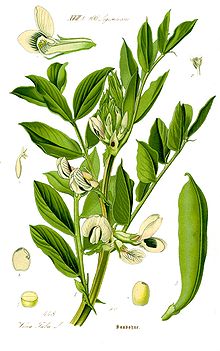Faba bean
| Vicia faba | |
|---|---|
 |
|
| Vicia faba plants in flower | |
| Scientific classification | |
| Kingdom: | Plantae |
| (unranked): | Angiosperms |
| (unranked): | Eudicots |
| (unranked): | Rosids |
| Order: | Fabales |
| Family: | Fabaceae |
| Subfamily: | Faboideae |
| Tribe: | Vicieae |
| Genus: | Vicia |
| Species: | V. faba |
| Binomial name | |
|
Vicia faba L. |
|
| Synonyms | |
|
Faba sativa Moench. |
|
| Nutritional value per 100 g (3.5 oz) | |
|---|---|
| Energy | 1,425 kJ (341 kcal) |
|
58.29 g
|
|
| Dietary fiber | 25 g |
|
1.53 g
|
|
|
26.12 g
|
|
| Vitamins | |
| Thiamine (B1) |
(48%)
0.555 mg |
| Riboflavin (B2) |
(28%)
0.333 mg |
| Niacin (B3) |
(19%)
2.832 mg |
| Vitamin B6 |
(28%)
0.366 mg |
| Folate (B9) |
(106%)
423 μg |
| Vitamin C |
(2%)
1.4 mg |
| Vitamin K |
(9%)
9 μg |
| Minerals | |
| Calcium |
(10%)
103 mg |
| Iron |
(52%)
6.7 mg |
| Magnesium |
(54%)
192 mg |
| Manganese |
(77%)
1.626 mg |
| Phosphorus |
(60%)
421 mg |
| Potassium |
(23%)
1062 mg |
| Sodium |
(1%)
13 mg |
| Zinc |
(33%)
3.14 mg |
|
|
|
|
|
| Percentages are roughly approximated using US recommendations for adults. Source: USDA Nutrient Database |
|
Faba sativa Moench.
Vicia faba, also known as the broad bean, fava bean, faba bean, field bean, bell bean, or tic bean, is a species of flowering plant in the pea and bean family Fabaceae. It is native to North Africa southwest and south Asia, and extensively cultivated elsewhere. A variety Vicia faba var. equina Pers. – horse bean has been previously recognized.
It is a stiffly erect plant 0.5–1.8 m tall, with stout stems of a square cross-section. The leaves are 10–25 cm long, pinnate with 2–7 leaflets, and of a distinct glaucous grey-green color. Unlike most other vetches, the leaves do not have tendrils for climbing over other vegetation. The flowers are 1–2.5 cm long, with five petals, the standard petal white, the wing petals white with a black spot (true black, not deep purple or blue as is the case in many "black" colorings,) and the keel petals are white. Crimson-flowered broad beans also exist, which were recently saved from extinction. The flowers have a strong and sweet scent which is attractive to bees and other pollinators. The fruit is a broad, leathery pod, green maturing to blackish-brown, with a densely downy surface; in the wild species, the pods are 5–10 cm long and 1 cm diameter, but many modern cultivars developed for food use have pods 15–25 cm long and 2–3 cm thick. Each pod contains 3–8 seeds, round to oval and 5–10 mm diameter in the wild plant, usually flattened and up to 20–25 mm long, 15 mm broad and 5–10 mm thick in food cultivars. Vicia faba has a diploid (2n) chromosome number of 12 (six homologous pairs). Five pairs are acrocentric chromosomes and one pair is metacentric.
Broad beans have a long tradition of cultivation in Old World agriculture, being among the most ancient plants in cultivation and also among the easiest to grow. Along with lentils, peas, and chickpeas, they are believed to have become part of the eastern Mediterranean diet around 6000 BC or earlier. They are still often grown as a cover crop to prevent erosion, because they can overwinter and because as a legume, they fix nitrogen in the soil.
...
Wikipedia
